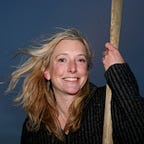The Wood Wide Web of Suzanne Simard
This is not about how we can save the trees. This about how the trees might save us.
John Muir said: “When one tugs at a single thing in nature, he finds it attached to the rest of the world.” Suzanne Simard is proving that this is quite literally true — that nature in general, and trees in particular, is not competitive, but is intricately interconnected in a web of mutual support and reciprocity.
You might have seen her 2016 TED Talk about how trees talk to each other. I’ve just finished listening to her audiobook (read by the author), Finding the Mother Tree. What strikes me most, following on from my blog post about Carl Safina’s Beyond Words (and also an older post about Braiding Sweetgrass, by Robin Wall Kimmerer) is this: not only is non-human nature so much more intelligent than we suspected, but we have fundamentally misunderstood that it is deeply rooted (so to speak) in relationship, not individuality. Trees thrive by sharing resources, not hoarding them. As Suzanne puts it:
“The trees soon revealed startling secrets. I discovered that they are in a web of interdependence, linked by a system of underground channels, where they perceive and connect and relate with an ancient intricacy and wisdom that can no longer be denied.”
Her work began when, as a young employee for a logging company, she intuited that British Columbia’s “free to grow” policy wasn’t working. The idea was that eradicating “weeds” would allow trees in plantations to flourish without competition for water, nutrients, or sunlight. But the trees were sickly and yellow, and many died.
Over the course of decades of research, Suzanne has discovered that the health of trees depends in large part on their subterranean network of fungal mycorrhizae that allows the sharing of nutrients — and maybe something more. Maybe even kinship.
Most animals don’t do well in isolation — witness tragic zoo exhibits of lonely pitiful creatures, often displaying signs of stress, depression and poor health, labelled zoochosis. Trees are not so different. They have richer family lives than we had imagined. Experiments have shown that a tree can tell kin from non-kin, and shares more generously with its own offspring.
“The older trees are able to discern which seedlings are their own kin. The old trees nurture the young ones and provide them food and water just as we do with our own children. It is enough to make one pause, take a deep breath, and contemplate the social nature of the forest and how this is critical for evolution. The fungal network appears to wire the trees for fitness. And more. These old trees are mothering their children.”
In a forest, the whole really is greater than the sum of the parts.
“Plants are attuned to one another’s strengths and weaknesses, elegantly giving and taking to attain exquisite balance. There is grace in complexity, in actions cohering, in sum totals.”
I reference the community of trees in my forthcoming book, The Ocean in a Drop, in relation to Iain McGilchrist’s work on the two hemisphere of the brain — the reductionist left hemisphere, and the holistic right:
“The left hemisphere quite literally can’t see the wood for the trees; here in the UK developers of a proposed high speed train link have promised to plant new trees to replace the ancient woodlands that will be cut down, ignoring the fact that a wood is a deeply integrated community evolved over centuries, not just a bunch of trees you can cut down in one place and replace with saplings somewhere else. The right hemisphere intuits the wood as a place of harmony and rejuvenation (think of Japanese forest-bathing), peopled by ancient trees and rich in diversity and relationship. The left hemisphere just sees a collection of individual, substitutable objects.”
Speaking of brains, Suzanne Simard sees a parallel between the wood wide web and our own synaptic connections:
“…the biggest, oldest timbers are the sources of fungal connections to regenerating seedlings. Not only that, they connect to all neighbors, young and old, serving as the linchpins for a jungle of threads and synapses and nodes. I’ll take you through the journey that revealed the most shocking aspect of this pattern-that it has similarities with our own human brains. In it, the old and young are perceiving, communicating, and responding to one another by emitting chemical signals. Chemicals identical to our own neurotransmitters. Signals created by ions cascading across fungal membranes. “
Trees have a lot to teach us about how to live in a thriving web of mutuality, in collaboration rather than competition. Suzanne’s book is inspiring and uplifting — interwoven with her groundbreaking research is her own story of personal and professional courage, often facing scepticism, dogma, prejudice and misogyny as she tries to convince scientists and loggers that they have missed something fundamental about the nature of trees. She concludes:
“The scientific evidence is impossible to ignore: the forest is wired for wisdom, sentience, and healing. This is not a book about how we can save the trees. This is a book about how the trees might save us.”
Find out more about Suzanne Simard’s current work at the Mother Tree Project.
Photo by Lukasz Szmigiel on Unsplash
Other Stuff:
A reminder that I have a couple of public speaking events coming up — tickets available via the links below. I don’t do public events very often, so I hope you’ll grab this rare chance!
Friday 27thMay: Solitude, Sustainability, and Systems Thinking: Rowing 3 Oceans for Change (UK, near Southampton) Thursday 9th-Friday 10thJune: Fifteen Seconds Festival (Graz, Austria): Riding the Waves of Change
PROMO CODE! 10 free festival passes available if you enter FSF22-FV6P3RUU at checkout
Originally published at https://www.rozsavage.com on May 20, 2022.
